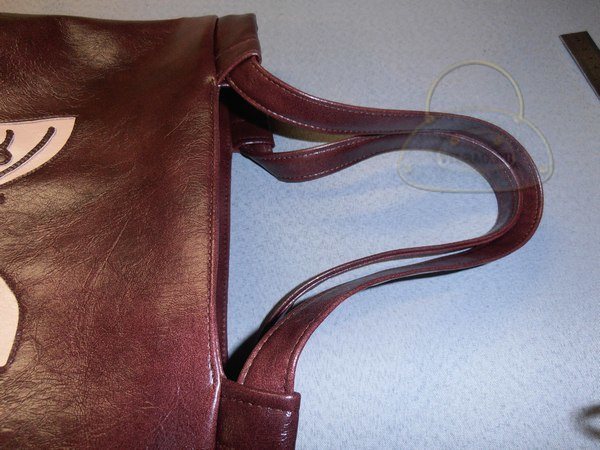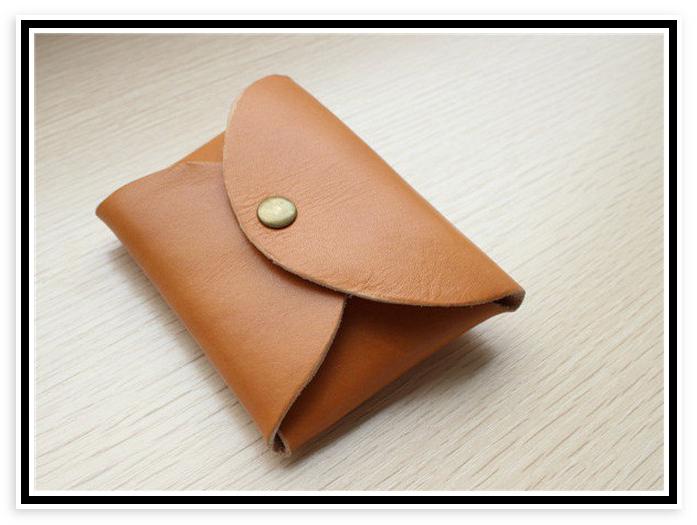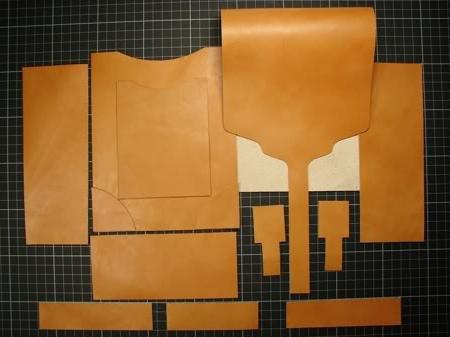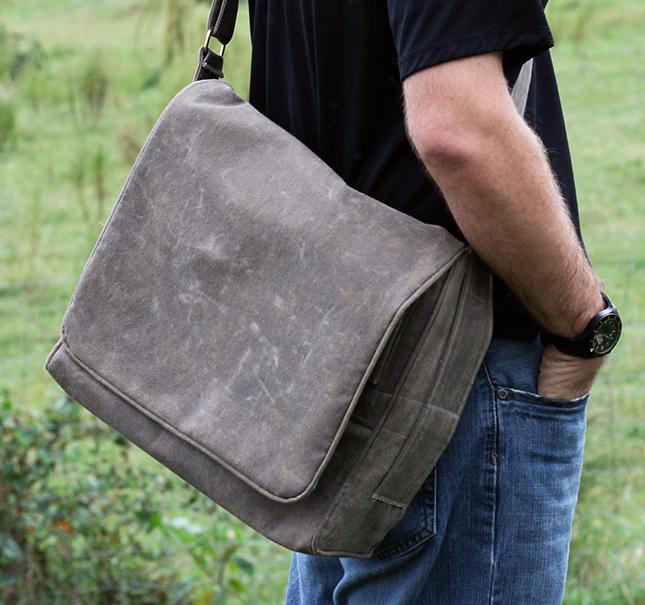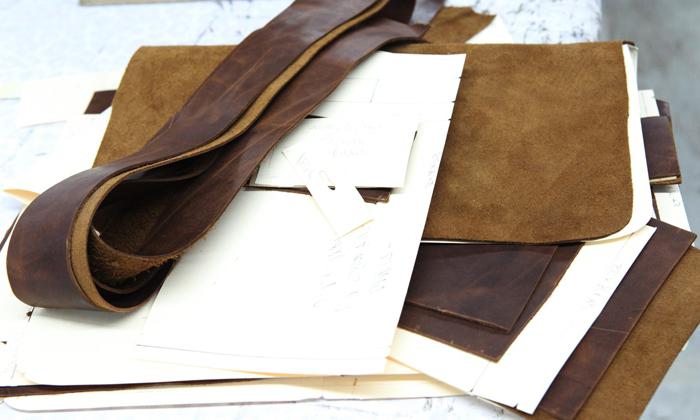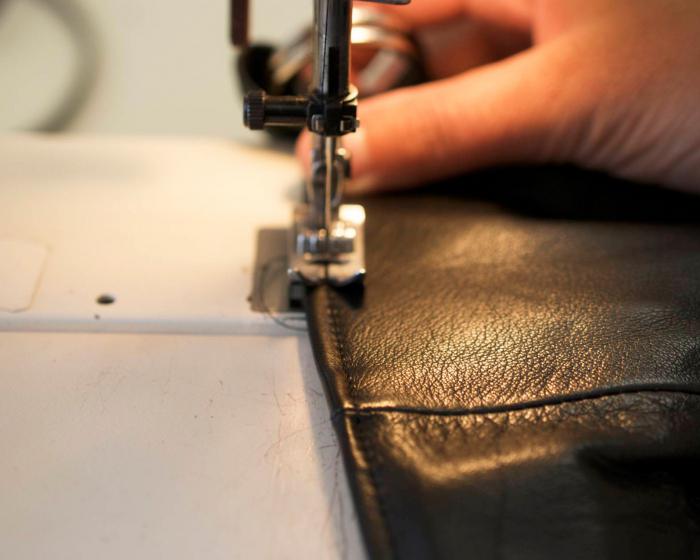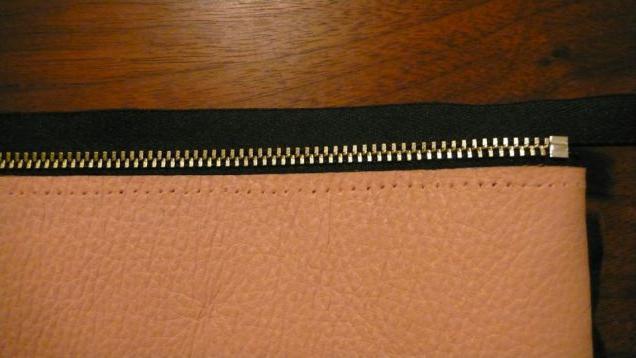Drawing of a fabric bag. Small bag
Today it is quite difficult to be original. The range of products is so wide that it is sometimes very difficult to choose something unusual. That is why in this article we will talk about how to sew a leather bag, and what should be taken into account.
Rules for working with leather
Initially, you need to know the rules of working with this or that material. That is why, before figuring out how to sew a leather bag, you need to know all the nuances and precautions in the work.
- To use a sewing machine you will need special needles. In some cases, you can also install a special foot (with a roller) for sewing leather products.
- For each product you need to be able to choose leather. So, for bags it should be extremely thick, rough-made. Only in this case will the product be able to long time serve its owner.
- When cutting parts, remember that leather stretches differently.
- Throwing or pinning skin is prohibited. After all, marks remain on it, which then do not disappear anywhere.
- The length of the machine stitch when working with leather should be as wide as possible. After all, if you sew a bag with a fine stitch, the leather may simply tear (press through) in the stitching areas, which will lead to the product tearing.
- It is better to cut the leather not with tailor's scissors, but with a special shoemaker's or stationery knife.
- The edges of the leather are not overlocked. After all, they do not have the property of rolling.
- Standard machine fastenings are not applied to leather. To prevent the product from coming apart at the seams, the thread on the wrong side must be tied into a knot.
- It is important to remember that high-quality sewing of leather products is simply impossible without the use of glue.
Ironing the product
Sewing leather bags necessarily includes the process of ironing the material. There are certain nuances here:
- The leather is ironed from the wrong side.
- When ironing, use low temperatures and do not use steaming. Overheating causes the skin to shrink and become hard. It will not be possible to soften it after this.
- It is best to iron the skin, even from the wrong side, through gauze or a special iron. This way you can protect the fabric from damage.
If the material is ready for work, you can begin the sewing process itself.
Envelope clutch
Today it is a fashionable accessory that simply must be in the wardrobe of every self-respecting girl. In addition, making it yourself is quite simple.
To make a perfect leather bag with your own hands, patterns are a must. After all, it is much easier to create a product using a template than to sew it, as they say, by touch. IN in this case the template is extremely simple: the design is based on a rectangle (its size is the size of the clutch). Next, you need to draw triangles in four directions from the sides. However, so that their edges do not coincide a little, they are wider (this is important, because when folding the clutch, things should not fall out of the bag).
Next, the product is cut out. At the next stage, holes are punched at the edges using a special device (a hole punch for fabrics). Three edges are folded to form an envelope. They are fixed with a rivet (threaded through the holes and secured on top with a round piece). The principle is something similar to a bolt and nut. The remaining piece of fabric is the “lid” of the bag, i.e. the part that will open in order to put or take something into the clutch.
Shopping bag
It is also extremely easy to sew this leather bag with your own hands. You don't even need patterns here. For sewing, you need two rectangular pieces of leather for the bag itself, two long narrow pieces for the handles. If you wish, you can make a lining.
At the very beginning, you need to sew two equal pieces of leather from the bottom and sides. This will be the bag itself. Next you need to prepare the handles. They are easy to make too. You need to fold a piece of leather in half, bend the edges of the handle into the middle so that everything looks beautiful on the outside. The handles can be initially glued with doublerin, which will significantly strengthen them. Next, they need to be stitched along the edge to secure them.
Then the handles should be sewn to the bag itself. To do this, the top of the product needs to be slightly bent into the middle. The handles are sewn a little along the length (to the top of the bag) and always along the width. In this case, the threads for sewing can be chosen to match the tone of the product, as well as contrasting color. That's all. The leather shopping bag is ready!
Men's bag
Pattern men's bags made of leather can also be extremely simple. What does a guy need? So that the bag can fit a laptop or papers. That is why the technology for cutting and sewing such a product is also extremely easy.
The bag size may be slightly larger than A4. So, for this you need to cut out two corresponding pieces of leather. This bag will also have a slightly widened bottom and a sewn-in zipper. To do this, you need to cut out two narrow but long pieces of leather:
- on the bottom - a size slightly less than the sum of the three sides of the rectangle (the bag itself);
- on the top - slightly larger than the wide side of the bag (the lock will be located there).
You also need to prepare two narrow and long pieces of leather for the handles (guys rarely wear such bags on their shoulders, so the handle straps may not be long).
At this stage, you can sew all the parts together. So, first the bottom of the bag is sewn to one side, then to the other. The result is an almost finished cavity.
Now we have to work on the top. Initially, you need to sew a zipper into the strip. So, for this you need to first cut it in the center. When this is done, you need to fold the cavity of the bag itself, two handles (how to sew them is described in the previous version) and fold the top the way everything should turn out in the end. Since you can’t throw, you can first fasten everything from the inside with binders or loose clothespins (however, they also sometimes press hard on the skin and leave marks, it’s worth remembering). We sew a leather bag for a guy next. Now we need to fasten all the parts together. To do this, the product is turned inside out. You need to remember that in this case there will be difficult to pass places (where the handles are sewn on). So don't sew at high speeds. That's all. If desired, the bag can be decorated with pockets.
Barrel bag
You can also sew a “barrel” (leather bag) with your own hands. In this case, the following patterns will be needed:
- The first piece is the top part of the bag (two pieces - on either side of the zipper).
- The second detail is the bottom.
- The third detail is two stripes on the handles.
- Fourth - two side parts.
- Other elements: two fastenings, two connecting strips.
In this case, it is worth noting that the bag will be sewn not by machine, but by hand.
First step: handle straps
Let's figure out how to make a leather bag. So, initially you need to work with the straps for the handles. They can be pre-glued with glue, and only stitched on top with decorative stitching. If the work is done manually, the skin will first have to be pierced with an awl. The needle simply won’t pick up such fabric. The straps are initially sewn to the first part on both sides. First, you must remember to insert a ring into them, to which the handle itself will be connected.
Second step: sewing the bag
We next consider the production of leather bags. At this stage it is necessary to connect the first parts together. So, to do this, you should slightly bend the ends where the zipper will no longer be sewn. Now we need to attach the snake. So, it can also be pre-glued to the skin with glue. Next, you should go through it with an awl and stitch it with thread.
Let's move on to the next step in the process of sewing a leather bag. Now you need to connect the finished top of the bag with the bottom. It's easy to do. You have to sew from the inside. If stitches of a contrasting color were laid on top, you will have to do the same along the bottom.
Step three: handles
When the bag is almost ready, all that remains is to work with the handles. So, they must be extremely strong in order to withstand the weight of everything that may be in it. This is why they can be strengthened by the skin itself. To make the handle voluminous, you can insert strips of used leather twisted into a braid or tube into the middle of it. Next, everything is stitched on the outside, first with a fastening stitch (you can also glue the handles with glue), then with a decorative stitch.
If desired, a lining can be inserted into the bag. It is sewn to the size of the bag, and after sewing it is glued in the middle so that the leather is placed on top of the lining fabric.
Stylish clutch
There is another option for sewing a clutch. In this case, you will also make a leather bag with your own hands. In this case, we will need extremely simple patterns. So, we only need to cut one rectangular piece of leather.
Initially, you will need to sew in a zipper. This is not difficult to do. So, it is worth noting that it can generally be glued. However, it is still better to “walk” along the top with a decorative seam, which will also secure it.
At this stage the bag is almost ready! Now we need to make an unusual bottom. To do this, the leather should be folded in the middle at the corners of the bag. It will look like the clutch has been cut off a little. These folds are stitched from the inside. The rest of the bag is stitched along the outside with decorative stitching. For beauty, you can also bend the corners of the product along the top, securing them with buttons. That's all. A stylish and unusual clutch is ready!
Decoration
Almost any leather bag can be very unusual and original. A master class on decorating - that's what we'll talk about now. So how can you decorate a leather product? There are several options here:
- Rivets, buttons. These are metal parts. They can be gold or silver color. Nowadays such elements are in fashion, so you can safely decorate your product with them. They pierce the skin quite easily, as they have sharp ends that bend and lock the part in place.
- You can decorate leather bags with zippers. It looks very nice. So, you can take one half of a zipper with intact teeth and sew it along the contour of the bag. Alternatively, you can twist the zipper in a circle (spiral) and make a very unusual decorative element. It can be either sewn or glued.
- Applications. You can also decorate the bag with leather or suede appliqué. Almost anything can be depicted. The picture can be sewn or glued.
- Embroidery also looks beautiful on leather bags.
That, in principle, is all that can be used to decorate a leather bag. This is what will look stylish and original. The main thing to remember is that it is important not to overdo it with decorations. After all, too much is ugly. Everything should be in moderation.
Leather bag care
Having examined various patterns of leather bags, photos finished products Finally, it must be said that any item made from this material requires special care.
You can revive a slightly tarnished or faded leather bag with a soap solution. However, before use, you need to add a little ammonia to it. After treatment with this product, the bag is thoroughly wiped and rubbed until shiny with a soft cloth soaked in castor oil or glycerin. Next, apply a thin layer of colorless cream to the bag. After it is absorbed, the product is wiped with flannel.
An onion can also be a good way to refresh your bag. To do this, you need to take half of this vegetable and rub the product with the cut. This product also perfectly hides scuffs on a leather bag, minor scratches and cracks.
If leather bag got shiny, this place needs to be wiped with a mixture of milk and baking soda. Preparing the solution is simple. Mix a teaspoon of soda in a glass of milk.
If the bag is made of suede, i.e. reverse leather, it also needs to be properly cared for. Such a product should be periodically wiped with a rubberized cloth or an eraser. You should not wash the material, as this will make it rougher. However, if necessary, the suede should be washed in a soapy solution, wiping it thoroughly after the procedure.
And, of course, it is worth remembering that today there are many different creams and sprays for skin care. They can be used if you want to extend the life of your favorite leather bag.
A small flap bag with a long strap will take its rightful place among your accessories. And you will learn how to make it yourself from my master class.
Hello dear needlewomen))) Finally, I will show you how I create my favorite handbags))) I apologize in advance for explaining myself in my own language wrong language because I haven’t completed any sewing courses and I don’t have anyone interested in it wonderful thing friends.. that is, there is no one to speak in terms with) But on the other hand, there will be so many pictures here that, perhaps, there is no need to say much.
Well, let's start)
For the handbag itself (as well as the lining, if it is made of the same fabric), I cut out 4 rectangles 28 by 23 cm (including allowances).
I measure 1.5 cm from the beginning of the dart, 4 cm to the sides and draw a rounded line along which I will then sew the parts.
I sew a pocket onto one of the 4 pieces.
I fold the 2 parts right sides together, pin them so that the darts match and sew them together. I cut off the corners.
I turn the bag inside out and sew loops for carabiners (for the strap) at the top. For the loops, I cut out rectangles measuring 7 by 3.5 cm.
For the front side of the valve, I made a patchwork-style blank. The squares are 6 by 6 cm (cut out 8 by 8), only the top one is longer, since the flap on top will go back... First, I sewed all the squares together, and then stitched them onto a rectangle made of the same fabric as the bag (for strength) .
From the outer squares I measure 6.1 cm (1 mm as a margin) and lay a line along which I will then sew the front and inner part valve
I round the edges and use a disk as a stencil (I really like its diameter).
I fold the outer and inner parts of the valve right sides together and chop them off ().
By the way, when I sew a valve from one layer thick fabric, then I definitely strengthen it with double tape, it must be dense, otherwise it will lie unsightly in waves.
And in this case, the valve on the front side consists of two layers (cotton patchwork + cotton), on the back side cotton + cotton, glued with double-sided adhesive).
After I have stitched the valve along the intended line, I cut off the allowances (leaving about 0.6-0.7 cm), and “at turns” I make notches in a checkerboard pattern.
I install a magnetic lock on the inner part of the valve, placing a rectangle of felt (so that the bent “antennae” do not show through from the front side).
I turn the valve inside out and sew along the edge.
After that I sew it to the edge using a machine.
I fold the bag and flap right sides together and stitch it.
Oh yes, I forgot to say - the flap is cut 2 cm narrower than the bag (since there are still loops on the sides). The length of the flap in this case is 20 cm (it covers almost the entire bag), it can be made smaller (for example, the red bag with hearts is only 15 cm long, including allowances).
Next you need to fold the front top part bags with front side with lining. About the stitching you see... The lining and bag are originally cut the same size, but the darts on such a thick fabric create some height (that is, they are thick, especially since one overlaps the other. So before sewing these pieces together I insert the lining into the bag, straighten it out well and it turns out that the lining sticks out a little in height from the bag itself. That is why I lay such a stitch, with which I then align the edge of the outer part of the bag (I hope someone understood something?).
As you can see, the lining is sewn not only along the front edge, but also catching a little of the back edge (as far as possible). Then the lining is turned right side out and inserted into the bag).
I fold it the way it should look in the end.
I tighten the valve and straighten it thoroughly.
And I mark with a pencil where the second part of the button needs to be placed.
I install the button (without grabbing the lining).
Then I sew the bag around the perimeter using a machine (previously, as you can see, there is a line that I sewed by hand). Special attention you need to pay attention to the sides where the loops for the carabiners are sewn. They turn out to be very thick (these sides) and need to be stitched very carefully.
For the strap, I cut out a strip 120 cm long and 7 cm wide (if the strap is made of the same fabric with a fold). To strengthen it I use adhesive tape. I don't know what it's called, but it's VERY dense. I glue the tape, then smooth out the seam allowances, and also fold the seam allowance on the opposite side inward.
I sew the edges of the strap and trim the corners. And the tape is not made completely, so that it would not be so difficult for the machine to then sew on the strap. But the tape should get onto the fold of the strap (on the carabiner).
Then I sew the strap around the perimeter and sew carabiners to it.
Well, that's all.
Our little bag is ready and I hope it will delight its owner.
Hello Craftswoman!
On this page I will tell you about my inspiration, which, oddly enough, came from a shopping bag I saw on the “weird moms” website.
I make this butterfly using the reverse appliqué technique in different handbags; my clients and my mother loved it. I also wanted a faux leather bag like this.
I share the dimensions, pattern of the bag and the stages of its creation:
The size of the finished bag is height 31.5 cm, width at the top 36 cm, width at the bottom 25 cm, bottom depth 12 cm.
We need faux leather, fabric for lining, zipper for back pocket, zipper for bag.
Cut:
1. Top parts 2 pieces, size 38*35 cm (mark the corners of the bottom 6*6 cm).
2. Top bar 2 pieces, size 38*4 cm.
3. Lining 2 parts, size 38*32 cm (mark the corners of the bottom 6*6 cm).
4. Handle part 115*6 cm.
5. Bar for handle – 2 parts, size 26*7cm.
6. Back pocket lining, 2 parts, size 24*18cm and 24*20cm
7. Pocket for lining, size as desired.
Detailed pattern of my bag, how I made it.
On the main part we mark all the necessary marks and lines:
- Corners of the future bottom
- Middle line for future application
- Line of the future pocket (from the top edge 5-6 cm, 20 cm long)
- Along the top edge we mark marks for the bar into which the handle will be pulled. When finished, it is 22 cm, which means we set aside the width from the side edge by the side seam allowance + 11 cm (1\2 strips).
We sew pockets onto the lining if desired. I have a double, open pocket + cell phone pocket.
Sew the zipper to the back pocket lining details.



We make appliqué on the outer part of the leather bag. I have a butterfly made using the reverse appliqué technique.


We sew the upper strips of leatherette to the upper edges of the lining, inserting a zipper.
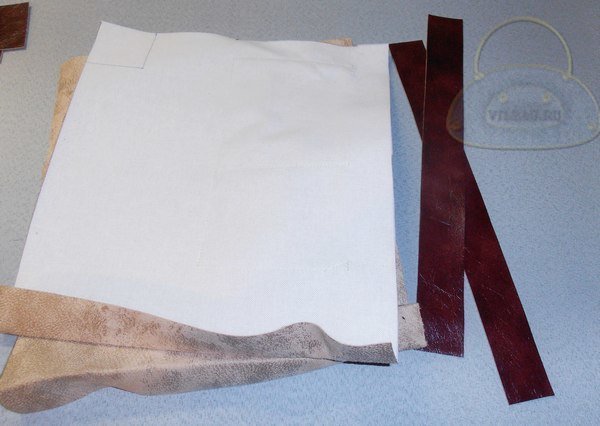

Connect the sides and bottom, leaving an opening for turning. We stitch in the corners to form the bottom.
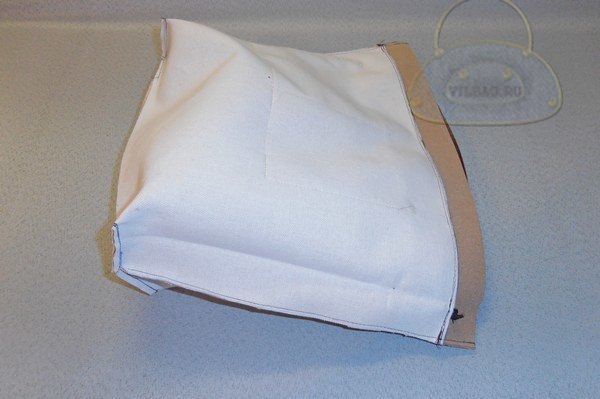
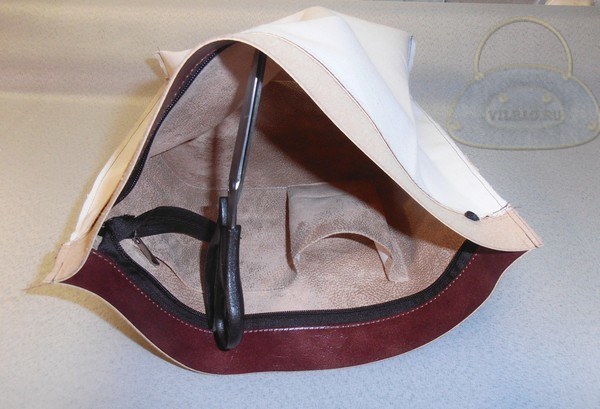
Prepare the hole for the back pocket. Insert the pocket lining with a zipper.

![]()
We connect the sides of the top part of the bag, stitch the corners, forming the bottom.

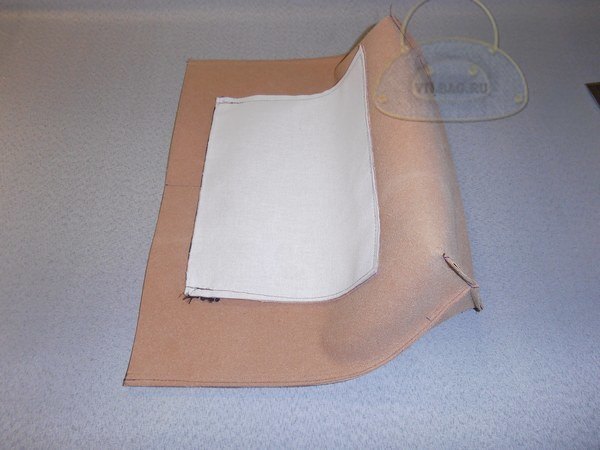
In my version, the handle did not turn out to be one-piece and I will join 2 parts together, the seams will be hidden in the upper strips. Forming a handle

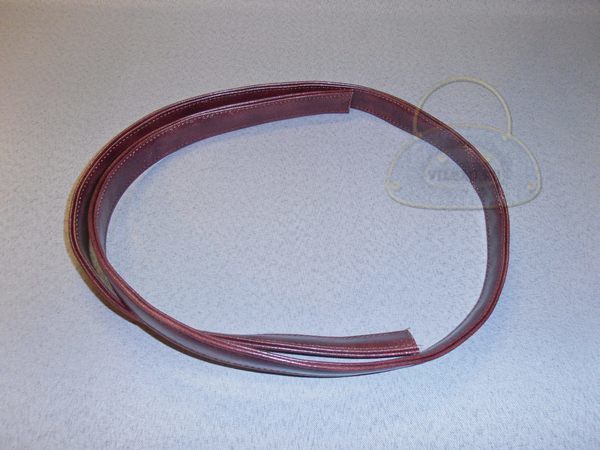
We wrap the edges of the handle bar 2 cm towards the wrong side, laying a fastening one. A line. Fold it across and attach it to the top strip of the lining, keeping the middle of the strip piece aligned with the side seam of the lining.


We turn the outer part of the bag inside out and put it inside the lining face to face, matching the sides and middle of the parts. We stitch connecting them.
Turn the bag inside out through the hole left when stitching the lining.
We lay a finishing stitch and thread the handle into special strips. We connect the handle into a ring and hide the seam inside the bar.
Sew up the hole in the lining.
